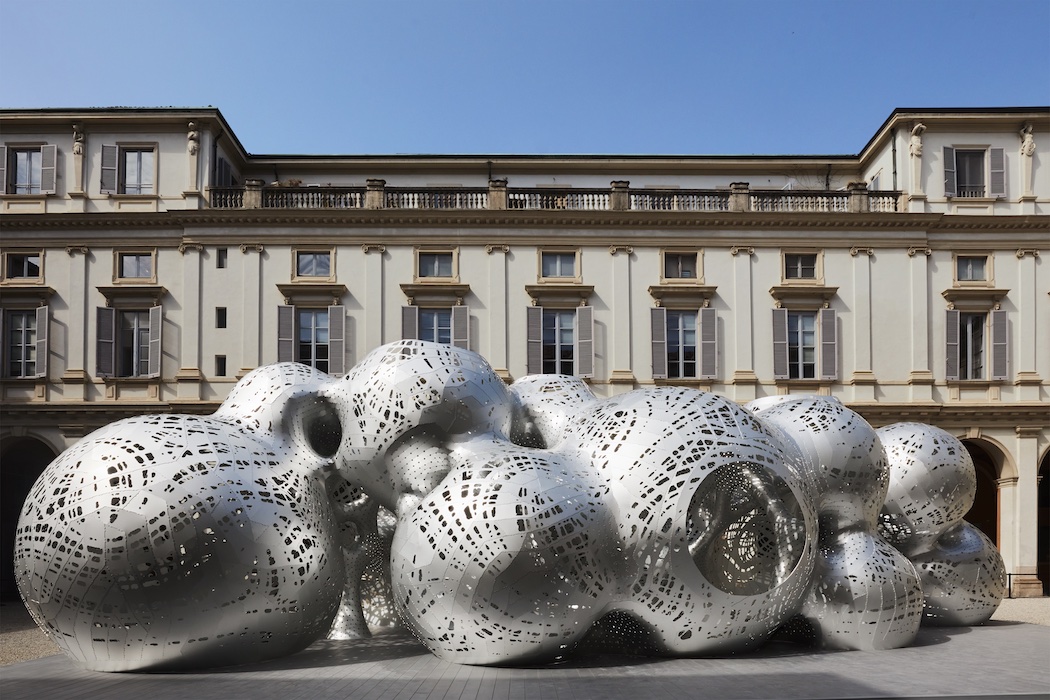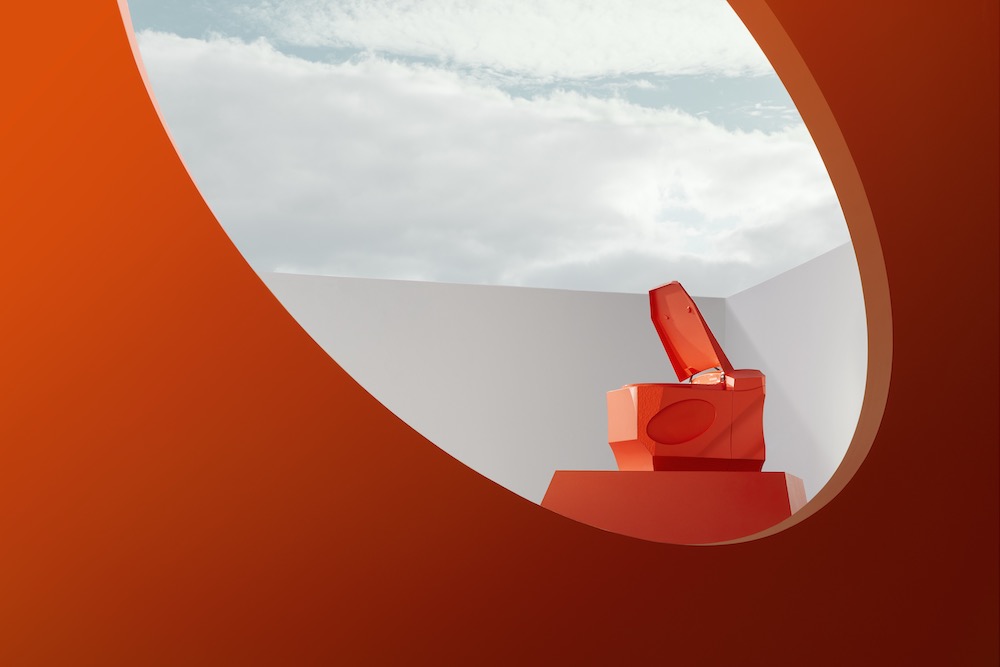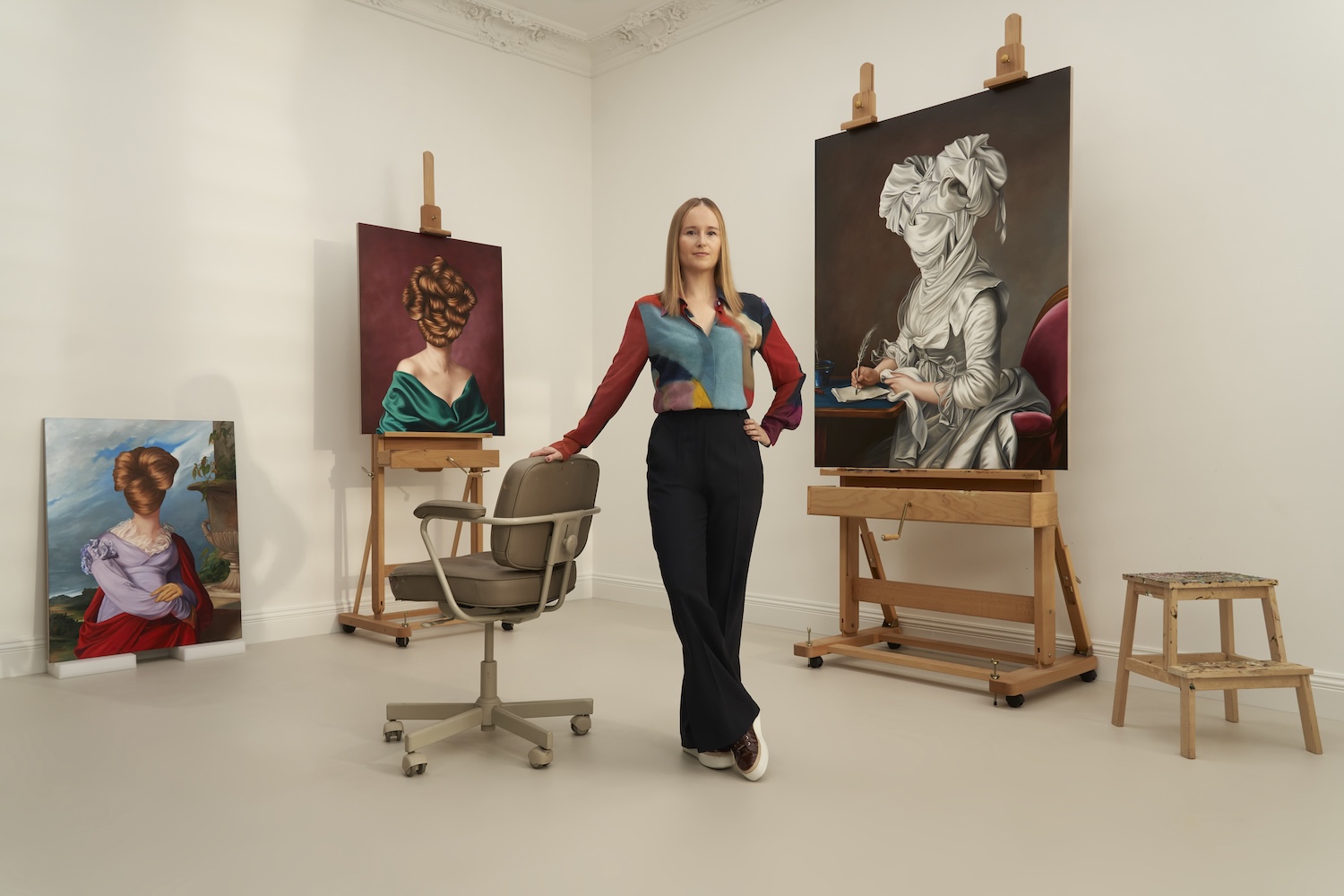During Design Week, the Fashion House Unveiled its New Objets Nomades Collection
In April during Milan Design Week, Louis Vuitton debuted one of its largest presentations for the annual event at Palazzo Serbelloni. On view were 11 new pieces from the Louis Vuitton Objets Nomades collection, created by collaborators Atelier Oï, Raw Edges, Atelier Biagetti, Marcel Wanders, Zanellato/Bortotto, and Estudio Campana. Rooted in the theme of travel, as the Objets Nomades collection has been since its inception in 2012, were two other unique projects: Marc Newson’s Cabinet of Curiosities and a nomadic pavilion by the French architect Marc Fornes.
The silver-colored, bubbling structure by Fornes filled the courtyard of the palazzo. The architect imagined a coral-like space composed of more than 1,600 anodized aluminum sheets, each with its own pattern and shape, with some measuring as thin as one millimeter. During the week, it played host to workshops, events, and discussions with Objets Nomades designers.
The duo behind Atelier Biagetti—and architect and artist, respectively—Alberto Biagetti and Laura Baldessari, have worked with Louis Vuitton’s artisans on the design collection since its beginnings. This year in Milan, they presented the Flower Tower lamp made of 15 bulbous flowers in glass stacked one on top of the other.
Whitewall spoke with both Fornes and Atelier Biagetti about the inspiration behind their Milan debuts—both were drawn to bubble-like forms and inspired by nature—and the role travel plays in their creative process.
A Nomadic Pavilion in Milan
WHITEWALL: Marc Fornes, what was the starting point for the installation during Milan Design Week?
MARC FORNES: The Milan Design Week is a marathon where the visitor is submitted to a lot of stimulation for the senses. It is very similar to a world expo, where every country or every brand is trying to catch our attention.
We needed the pavilion to attract curiosity, yet with a form of restraint, since so many brands are going for the loud and colorful. In the end, we focused on proposing foremost an experience, a complete universe very different from our daily environment, yet made from one single surface, hyper-thin.
WW: How did the setting of Palazzo Serbelloni inform the project?
MF: It’s scale. The courtyard is so large, with such a strong classical composition. We established directly that we had to create a mix between contrast and blend. While the overall organic form attracts at first by contrasting with the rectilinear courtyard, at night or on a sunny day, thereflection of its soft skin within all the surrounding windows is creating a feeling of symbiosis with its context.
WW: Can you tell us about the inspiration behind the form?
MF: The intent was to offer the visitor a unique experience, for him to travel and immerse himself into a complete universe, one that is very different from your daily environment.
We are interested in going back to a more intuitive sense of discovery. One should not be able to close their eyes and directly be able to redraw the space. One should have to walk through the space to understand it, but also go back and every time discover a new moment, a little subtlety on the skin, wondering what is the logic behind the openings, a different acoustic—one envelope, one skin, one material, yet composing so many differences.
The pavilion is challenging the perception of depth. The overall form is all continuous. There are no corners or edges to cast shadows and help your brain understand distances. And when it is a sunny day, it is the opposite. The intense motif of shadows from the openings overlapping onto the skin is blending everything in a different way.
We often wonder how one would describe such a space to someone who cannot see? One cannot describe it with typical architectural vocabulary such as walls, columns, beams, windows. One has to borrow from different fields, talk about depth, skin segmentation, network, branching, recombination, and continuities.
WW: What does the coral-like shape represent for you?
MF: Organic forms in general have two interests to me. The first is that everyone is inspired by such forms and can project all sorts of references on them depending on their background: Does it look like an organism one might have seen in a natural history book, a section of a skeleton seen in a museum, a coral formation during a dive in the ocean, or simply a specific flower picked during a trek in the outdoor? It does not really matter what each one sees in those forms; it matters that everyone can figure out a personal link and therefore is interested in the space.
The second is that those forms are curved in two directions, becoming extremely stiff through their geometry. They are extremely performant in terms of structure, requiring only a minimum amount of systems and materials. What you see is what you get. No additional supports, columns, or hidden beams. A certain form of essentialism and lightness contributes to the experience.
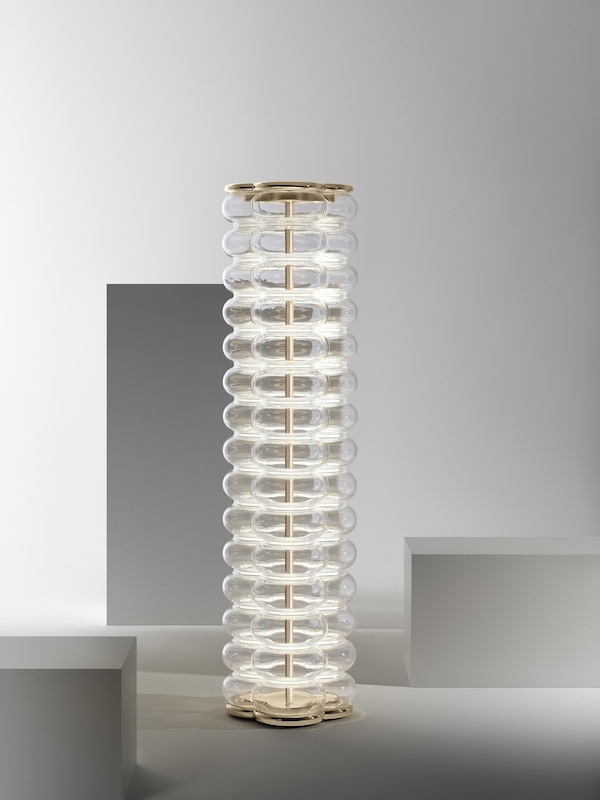
The Atelier Biagetti Flower Tower for Louis Vuitton Objets Nomade, photo by Philippe Lacombe, courtesy of Louis Vuitton.
A Flower Tower for Louis Vuitton Objets Nomades
WW: Atelier Biagetti, what was the starting point for Flower Tower?
ATELIER BIAGETTI: We started to work on this new piece thinking about a luminous landmark, a celestial totem as a point of reference of a contemporary domestic landscape. The title itself is a positive message about a possible transcendental futuristic paradise, which gives us a sense of liberty and of clean, fresh, unprejudiced equilibrium with the natural environment around us.
WW: Atelier Biagetti, how did you arrive at translating the Louis Vuitton monogram into flower-shaped bubbles in glass for the Objets Nomades lamp?
AB: The shape of this piece is inspired by the Louis Vuitton monogram flower shape even if it is not immediately recognizable, the idea to use the monogram came at the end of the design process when we decided to turn the blown glass part into glass flowers. This choice was driven by the title “Flower Tower.” We think that words are fundamental in driving the creative process.
WW: What kind of light effect did you want to create with this tower?
AB: A celestial sculpture, a luminous object related to the idea of magic as metaphor of our inner light—not a lamp, but an infinite column of light.
WW: What materials were you drawn to?
AB: Flower Tower is made by crystalline blown glass and invisible light. It’s a piece without boundaries, pure at the core; it’s an object in between virtual and physical space, a fragile and translucent sculptural and functional piece. Materials are strongly related to our psychology and part of the visible and legible DNA of each work we do.
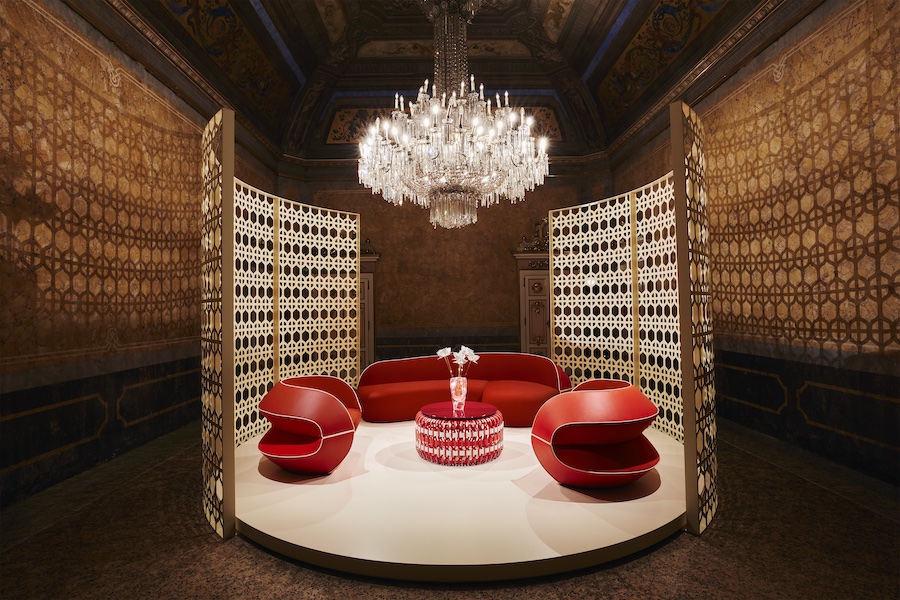
Installation view of Louis Vuitton Objets Nomades in Milan, courtesy of Louis Vuitton.
WW: And Marc, how did you arrive at the material of the pavilion? And of what significance is its thickness?
MF: The skin is everything. It is a unified system providing the envelope, the identity, the experience, but also the structure. The strength of such a structure is not in its material but in its geometry.
Our millimeter-thin surfaces are significant to reduce self-weight, means of installation, allowing for seemingly impossible forms at a thinness generally unseen in the built environment. It pushes the visitor to question his surroundings made from heavy beams and numerous columns.
Ultra-thin is both a vector for curiosity and disbelief. While younger kids run to the structure to play and interact, the older visitors tend to first stop at the entrance and touch the edge, wondering how is that even possible.
WW: What were some considerations you had to keep in mind in terms of form and function?
MF: Logistics! We knew such a Pavilion Nomade had to be assembled fast and might travel. This is the reason why the outer shape is made from an aggregate of spheres. They are all of different radiuses so that they can nest into each other for ease of transport and storage.
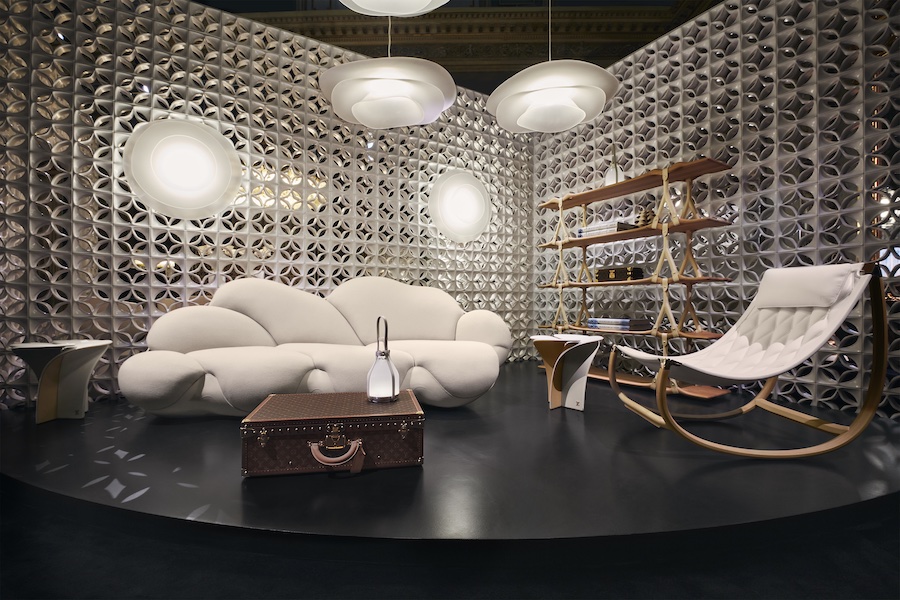
Installation view of Louis Vuitton Objets Nomades in Milan, courtesy of Louis Vuitton.
The True Meaning of Louis Vuitton Objets Nomades
WW: Speaking of travel, which is at the heart of the Louis Vuitton Objets Nomades collection, what role does travel play in each of your creative practices?
AB: Travel is a wonderful way to explore, to leave our house and any comfort related, sometimes meaning leaving our family and friends. It’s a way to change our equilibrium; everything is new, and nothing is ours in the places we visit. Sometimes we are alone, but the air, the dreams, the sea, and the sky remain the same.
Travel is a way to grow faster and allows us once again to take inspiration from the world around us, understanding and creating it. The objects we have designed are not static. They demand action, interaction, and an emotional relationship. We like to think that they have the power to bring people together, to tell stories, reminding us who we are, where we are going, and what are our dreams.
MF: Travel is essential to me, in general. I was born on a line between France and Germany. We are French, but some of our best food and wine are more Germanic. My great granddad actually changed nationality four times during his life, and we can visit four different countries within a one-hour range. So very early on, I had a very different understanding of the sense of belonging to a space. It inspired me to move and live in different countries, never judging, always trying to learn from the other side, trying to understand the subtle differences. This is what design is about, trying to articulate differences that are formal, programmatic, or societal, and tell that story.
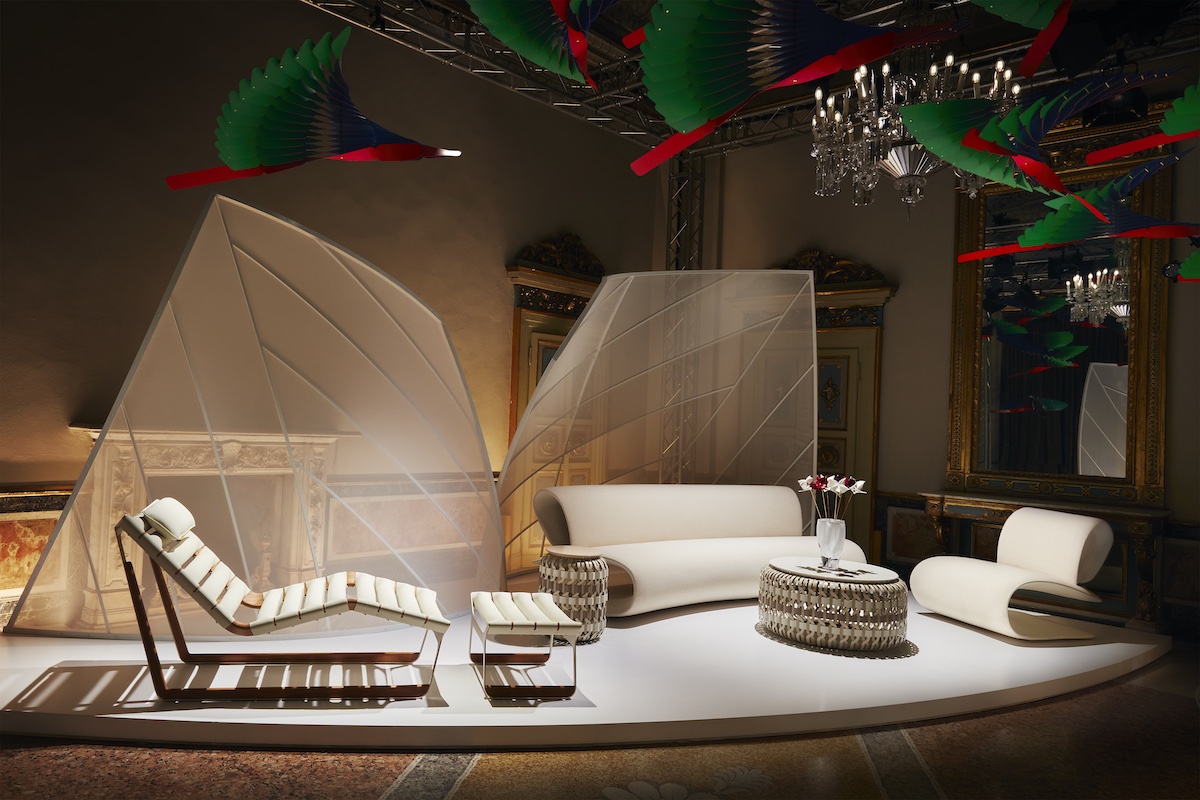
Installation view of Louis Vuitton Objets Nomades in Milan, courtesy of Louis Vuitton.



